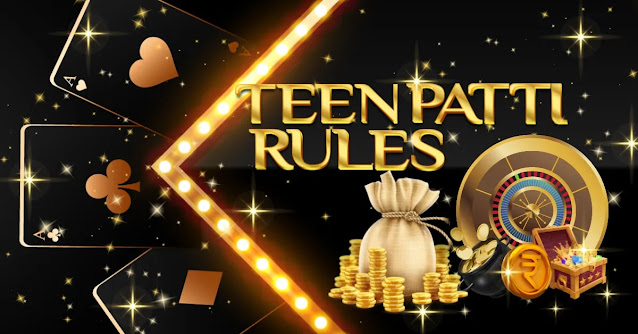Tips Tricks in Playing 3 Patti Sequence | Popular Card Game!
Tips Tricks in Playing 3 Patti Sequence | Popular Card Game!
Want to learn how to play 3 Patti Sequence, a popular card game in India?
Have no fear. The full set of Teen Patti guidelines is provided in this article.
One of the most well-known card games in India is Teen Patti, a variation on the traditional Indian card game of Poker. Do your best to learn the rules of Teen Patti India and get a feel for the game.
One of the most popular card games in all of South Asia has its roots in India. This is a kind of three-card poker called "flash" or "flush."
Find Out the Basics of Teen Patti and How to Play the Game
Using a standard 52-card deck (no jokers), players of Teen Patti (a popular Desi card game in India) can compete against each other in rounds. Similarly to other poker and rummy games, Teen Patti India begins with the placement of a token. Participants must agree on an initial bet amount before any cards are dealt.
Players receive three face-down cards after placing their tokens and calculating the total. The boot sum is the initial supply of tokens in the game. We've set the pot down in the middle of the table.
Each player and the sellers will receive three cards before the next round of betting begins with a call or a raise. If you're familiar with Poker, a popular card game in India, you should already know what these mean. Play to win or lose more than the starting gaming token by calling to stay in the game without increasing his token, or by raising to increase his token's value in the pot.
Remember that Teen Patti, a popular Desi card game in India, is not the same as Poker. Because of this, if one person bets two coins and another bets four, the first player must increase his bet to six coins to make it even.
The player who stays in the game until the end of the hand and has the best or highest hand wins the pot, which accumulates over the course of the game. The cards are ranked in order of importance, and the winner is determined by that.
Hand Ranks: 3 Patti Rules, A Popular Desi Card Game India
Teen Patti is a popular card game in India, and in order to win when playing it online, you need to have a better hand than your opponents. In the card game 3 Patti, sequences (sometimes called hands) are ranked from best to worst.
Trail Rr Set (three of the same rank)
Any three cards of the same kind, regardless of color or suit, can form a trail, set, or trio in Teen Patti. Examples of trailing hands are three Aces, one club, one diamond, and one heart, which is the best possible hand.
The same is true of the separate ranks occupied by three Aces of the same suit (Ace of Clubs, Ace of Diamonds, Ace of Hearts). It's a tie between the Queens, Jacks, 10s, and the remainder. The worst possible numbers are 2-2-2.
Pure Sequence Or The Straight Flush
In the Indian card game of Teen Patti, this particular sequence of three Patti hands is referred to as a pakki round. Specifically, it's three cards in a row all of the same suit. In the classic card game, an A-2-3 of hearts, diamonds, spades, or clubs is the best possible sequence and receives the highest possible grade.
In some contexts, though, the letters A-K-Q are considered the most prestigious. At the end of the list, 4-3-2 is positioned last. In case you hadn't noticed, pure sequences of the form 2-A-K and K-A-2 are both invalid.
Sequence (straight or run) (straight or run)
In the game of Teen Patti, a run or straight sequence is quite similar to a pure sequence. The hand consists of three consecutive cards of varying suits. Even in the classic version of the game, an A-2-3 is the best possible hand.
The variant, however, changes the sequence to A-K-Q. With a 4-3-2, you have the series' worst hand. The sequences 2-A-K and K-A-2 are clearly not possible as a straight sequence.
Color
A color or flush in Teen Patti is a hand containing three cards of the same suit, regardless of their rank. In this ranking, the highest possible hand is an A-K-J of spades, clubs, diamonds, or hearts, followed by an A-K-10, an A-K-9, and so on. 5-3-2 is the lowest-ranking color or flush sequence.
Pair (two cards of the same rank)
Teen Patti pairs are constructed from any two cards of the same rank, regardless of color or suit. Teen Patti’s highest-ranking pair is two Aces of any color or suit. In the event that two or more players are dealt the same pair of cards, the highest-ranking hand is determined by the value of the "odd" card.
The sequence A-A-K is the best possible, whereas the sequence 2-2-3 is the worst possible.
High Card
Patti, who is only a teenager, has a high card that looks like a flush. The hand is made up of three random cards of different suits. An A-K-J is the finest possible hand, while a 5-3-2 is the worst. The following high card decides the higher-ranking hand if two players have a common high card.
Start The Game
Before we get into the intricacies, check out this video to learn how to play Teen Patti game.
Rounds Of Gaming
You can choose to play Chaal, a popular Desi card game India, (see the cards) or blind before placing your initial token (not seeing the cards).
When playing blind, you must bet at least the ante but no more than two times the ante. If the ante is 15, for instance, the smallest possible token bet would be 15. A maximum of 30 tokens may be placed.
When playing chaal, a common card game in India, you need to double the bet of the blind players if you want to keep playing. The maximum bet is limited to four times the total.
Popular card game in India that follows these rules.
You can either call or raise every time you place a token from now on:
Every round's largest token multiplied by the total number of rounds equals a call.
A raise occurs when one player's token total surpasses that of every other player. Only four of the highest-value token may be played at a time in chaal. When playing blind, you're limited to playing only twice as many of the highest token.
Play will continue until one of the following conditions is met:
Everybody else had given up and left the table. As the sole remaining player, you win the entire pot if everyone else folds.
No one stays in the game beyond the final two. There will be two players left, and one of them can request a show. If this happens, both players will have to reveal their hands and compare them. The winner is the player who has the highest ranking hand.
The gaming will continue until one of the following events occurs:
Everybody else had given up and left the table. As the sole remaining player, you win the entire pot if everyone else folds.
No one stays in the game beyond the final two. There will be two players left, and one of them can request a show. If this happens, both players will have to reveal their hands and compare them. The winner is the player who has the highest ranking hand.
"The Show"
When everyone but the last two players has folded, one of them can request a showdown. In this situation, both players must show their hands. The regulations of the program are as follows:
Two contestants are required for a show to take place.
In the event that there are still two players, any one of them may make a request for a show. They must both wager one time the current sum.
No one, not even the players themselves, may look at their cards before they've paid for the privilege.
When there are only two contestants left, the winner gets to pick the show. Each of them will double the current token price.
A player who is visually impaired has the option of requesting a performance from another player.
For the blind token to be worth the same as the current token, the current token's value must be multiplied by 1. For the Blind players, the doubling of the normal betting requirement is in effect.
There can be no show requested by a blind player. The participant can either take part in the game or withdraw from it.
All cards are shown in the show, for both players. Whoever has the best five-card poker hand at the end of the round is the winner of the pot.
If both players have identical hands, the player who paid for the show loses.
The winner of each hand acts as dealer for the next round.
Compromise
When playing Chaal, you can also try to negotiate a compromise, often known as a side show. The steps to a successful negotiation are as follows:
The initial step for every player is to put in at least (Ante).
When it's your turn to place your next token, you can negotiate a compromise with the player who placed before you (the person to your left). To do so, however, requires that the player in front of you be playing Chaal.
We recommend putting the current amount from the player before you.
The other party can choose whether or not to accept the concession.
If the other party agrees to the compromise, you must both reveal your cards. It's a given that whoever has the worst hand of the two must fold. A request for a compromise should be considered a fold if the cards are tied.
When the other player does not accept the proposed middle ground, the turn is passed to the next player.
Check out our website Hobi Games if you want to learn and discover more things about this.
.png)


Mga Komento
Mag-post ng isang Komento